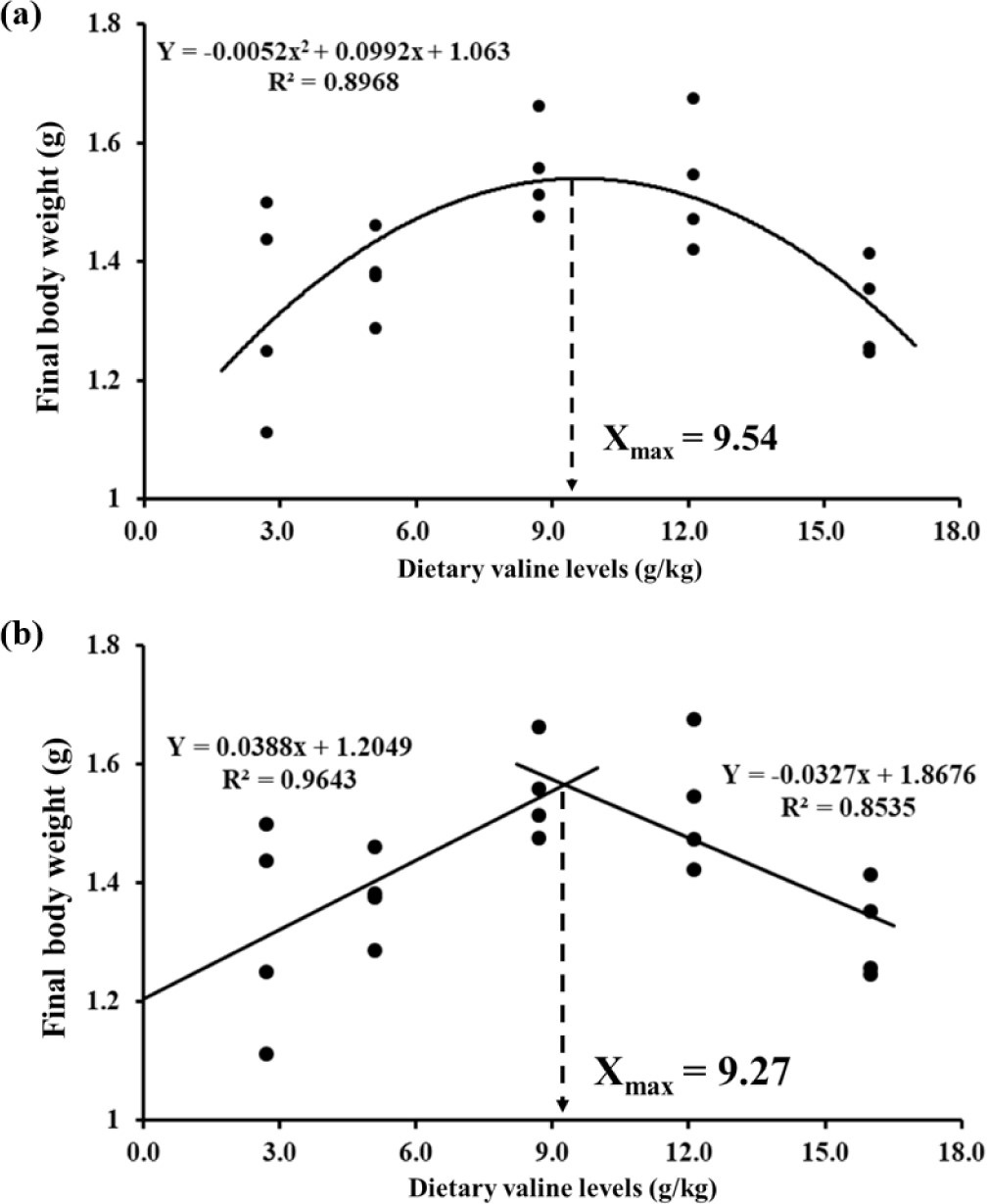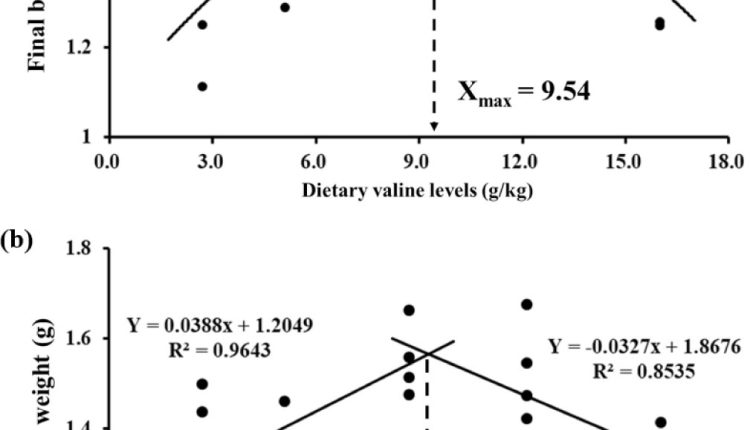DETERMINATION OF OPTIMAL DIETARY VALINE CONCENTRATIONS FOR IMPROVED GROWTH PERFORMANCE AND INNATE IMMUNITY OF JUVENILE PACIFIC WHITE SHRIMP (PENAEUS VANNAMEI)
A study evaluated the dietary Val requirement for Pacific white shrimp (Penaeus vannamei) using five isonitrogenous and isocaloric diets with Val levels of 2.7, 5.1, 8.7, 12.1, and 16.0 g/kg. Over 8 weeks, groups of 12 shrimp (average weight: 0.46 g) were fed these diets at 2%–5% of their body weight. The highest weight gain occurred in the 8.7 g/kg Val group, while growth declined at levels above 12.1 g/kg. The feed conversion ratio improved with 2.7 and 16.0 g/kg Val, but shrimp on the 2.7 g/kg diet had lower protein efficiency and Val concentrations. Notably, Val inclusion enhanced the expression of insulin-like growth factor binding protein and immune-related genes in the hepatopancreas, with the 8.7 g/kg group showing the highest expression. The study concluded that the optimal dietary Val requirement for maximum growth in juvenile P. vannamei is approximately 9.54 g/kg (27.2 g/kg based on protein), with maximum growth observed at 9.27 g/kg (26.2 g/kg based on protein).
1. Introduction
Valine (Val) is a branched-chain amino acid (BCAA), as well as an essential amino acid (EAA), with antioxidant and anti-inflammatory properties, which is utilized as a dietary supplement in aquaculture feed (Zhao et al., 2023). Val has been reported to play important roles in various physiological functions in animals including protein synthesis, energy production, immune functions, and tissue repair (Zhang et al., 2017). The effect of Val on animal immunity has been extensively studied; for example, Chen et al. (2017) found that Val is involved in macrophage phagocytosis and plays a prominent role in inhibiting arginase activity to stimulate nitric oxide production. Several studies have found that optimum dietary Val levels can enhance growth and feed utilization in fish and shrimp species, including, black tiger shrimp (Penaeus monodon) (Millamena et al., 1996), red seabream (Pagrus major) (Rahimnejad & Lee, 2013) and largemouth bass (Micropterus salmoides) (Zhao et al., 2023).
Val is one of the most limiting EAAs in black tiger shrimp (Millamena et al., 1996) since it cannot be biologically synthesized in vivo; therefore, dietary supplementation of sufficient amounts of Val is required in aquafeeds (Coloso & Cruz, 1980; NRC, 2011). In fish, dietary Val deficiency has resulted in limited growth and poor non-specific immune responses in rainbow trout (Oncorhynchus mykiss) (Ahmad et al., 2021), hybrid grouper (Epinephelus fuscoguttatus ♀ × Epinephelus lanceolatus ♂) (Zhou et al., 2021) and Nile tilapia (Oreochromis niloticus) (Xiao et al., 2017). An excess of dietary Val was reported to affect negatively on the growth performance and innate immunity in golden pompano (Trachinotus ovatus) (Huang et al., 2017). Even though, the effects of dietary Val on fish immunity are well understood (Luo et al., 2014; Xiao et al., 2017), the use and efficacy of Val supplementation to enhance shrimp immunity are poorly described.
Fish meal (FM) has been considered as the supreme protein source in aquaculture industry owing to its excellent quality of protein, such as high crude protein and well-balanced amino acid (AA) profile. However, it has become unsustainable to utilize FM as a main feed protein source in aquafeeds mainly due to higher price and increased demand of pelagic fishes for human consumption (Olsen & Hasan, 2012). One potential mode of utilizing plant protein sources replacing FM is to supplement or fortify the diets with EAA. Understanding and quantifying the EAA requirements of shrimp is critical when optimizing least cost feed formulations in aquaculture industry.
Pacific white shrimp (Penaeus vannamei) is one of the most important shrimp species in global aquaculture. The requirements of EAAs such as arginine (Zhou et al., 2012), lysine (Xie et al., 2012) and threonine (Zhou et al., 2013) for P. vannamei have already been investigated. Nonetheless, to the best of our knowledge, the dietary Val requirement has not been determined for P. vannamei. Therefore, this study aimed to determine the optimal dietary Val requirement based on the growth performance, feed utilization efficiency, protein synthesis and non-specific immune responses of juvenile P. vannamei.
2. Materials and Methods
2.1. Experimental diets
A basal diet was created using a Val-free crystalline amino acid mixture, with the addition of 5% squid liver powder to improve palatability. To achieve specific levels of valine (Val), crystalline Val was incorporated at varying amounts (0, 4, 8, 12, and 16 g/kg) by replacing L-glycine, targeting final Val concentrations of 3, 6, 9, 12, and 15 g/kg. The actual Val levels measured in the diets were 2.7, 5.1, 8.7, 12.1, and 16.0 g/kg, respectively. The preparation involved thorough mixing of dry ingredients, followed by the addition of fish oil and distilled water, and the mixture was extruded into 2 mm pellets, dried, and stored at -24°C for future use.
2.2. Shrimp and feeding trial
Juvenile P. vannamei were acclimated for one week before being distributed into 20 tanks, each with a capacity of 120 L, containing 12 shrimp of similar size (average weight 0.46 g). The shrimp were fed diets four times daily at 2%–5% of their total body weight for eight weeks. Weight and number of shrimp in each tank were measured every three weeks to adjust feed amounts based on specific growth rate (SGR). To minimize stress, shrimp were fasted for 18 hours before weight measurements. The photoperiod was set to 12:12 (light:dark), and continuous aeration was provided to maintain dissolved oxygen levels. Water quality was managed by exchanging 70%–80% of the rearing water every three days, maintaining temperature between 29.6°C–30.6°C, dissolved oxygen at 5.56–6.01 mg/L, salinity at 33 ppt, and pH between 7.65–7.81. Total ammonia nitrogen levels were kept below 0.08 mg/L throughout the trial.
2.3. Sampling procedure and analytical methods
After the completion of the feeding trial, all shrimp were individually weighed to determine final body weight (FBW), weight gain (WG), specific growth rate (SGR), protein efficiency ratio (PER), feed conversion ratio (FCR), and survival rates. Eight shrimp from each tank were randomly selected, anesthetized in ice water for three minutes, and their hepatopancreas were collected under sterile conditions. These samples were immediately frozen in liquid nitrogen and stored at -84°C for subsequent analysis of gene expression related to prophenoloxidase (proPO), lysozyme, crustin, and insulin-like growth factor binding protein (IGF-BP). Additionally, four shrimp were frozen for whole-body proximate composition and amino acid (AA) concentration analysis.
The analysis of dry matter, ash, and crude lipid content was conducted following the guidelines set by the Association of Official Analytical Collaboration (AOAC) in 2005. Crude protein levels were measured using an automatic Kjeltec Analyzer Unit 2300. The amino acid compositions in both the diets and whole-body samples were determined with an automatic AA analyzer.
For gene expression analysis, total RNA was isolated from the hepatopancreas tissue, and cDNA synthesis was performed according to the methods outlined by Hasanthi & Lee (2023). The primer sequences for the genes analyzed are provided in Table 2, with β-actin serving as the reference gene. The relative mRNA expression levels were calculated using the 2-ΔΔCT method, and gene expression analysis was performed using qRT-PCR technology.
2.4. Statistical analysis
The data were subjected to one-way analysis of variance (ANOVA) using SPSS version 24.0 (SPSS, Chicago, IL, USA). Data of each parameter were initially checked for normality. Mean differences among dietary groups were determined by Duncan’s multiple range test, with significance at p < 0.05. A polynomial regression model and broken-line regression model were used for the determination of optimum dietary Val level based on shrimp FBW. The data were presented as mean ± SD. The percentage data were transformed into arcsine values prior analysis. Orthogonal polynomial contrast was used to assess whether the effect was linear and/or quadratic.
3. Results
The trial results demonstrated that shrimp growth performance improved with increasing dietary Val levels up to 12.1 g/kg, with the best outcomes in terms of final body weight (FBW), weight gain (WG), and specific growth rate (SGR) observed at this level. Conversely, the lowest growth metrics were recorded in shrimp fed a diet containing 16.0 g/kg Val, although these values were not significantly different from those in the 2.7 and 5.1 g/kg Val groups. The protein efficiency ratio (PER) was significantly higher in shrimp receiving 8.7 and 12.1 g/kg Val diets compared to other groups. Additionally, shrimp on the 8.7 and 12.1 g/kg Val diets exhibited a significantly lower feed conversion ratio (FCR) than those on the 2.7 and 16.0 g/kg Val diets.
Daily feed intake (DFI) remained consistent across all dietary groups, indicating that Val supplementation did not affect feeding behavior. Notably, the relative expression of IGF-BP was significantly elevated in the 8.7 g/kg Val group compared to all other diets. Shrimp survival rates ranged from 73% to 77%, showing no significant impact from Val supplementation. Overall, the FBW, WG, SGR, and IGF-BP expression exhibited significant quadratic trends in relation to dietary Val levels, suggesting a complex relationship between Val intake and shrimp growth performance.

Fig. Relationship between final body weight (g) and dietary valine levels based on (a) polynomial regression method and (b) broken-line regression analysis, where X represents the optimal dietary valine level for juvenile Pacific white shrimp (Penaeus vannamei).
4. Discussion
In this study, shrimp fed Val-deficient diets (below 5.1 g/kg) exhibited decreased growth performance and feed efficiency, while performance improved with Val levels up to 12.1 g/kg. The estimated Val requirement for shrimp (9.27–9.54 g/kg) aligns with previous findings for various fish species but is lower than that for black tiger shrimp and other fish. The variability in Val requirements across species and growth stages suggests the need for tailored dietary formulations.
The research also revealed that dietary Val supplementation upregulated the expression of insulin-like growth factor-binding proteins (IGF-BP) in shrimp, likely through the activation of the mTOR signaling pathway. This upregulation correlated with improved growth performance, indicating that Val may enhance growth by influencing key metabolic pathways.
Conversely, both Val deficiency and excess negatively impacted growth performance. Excess Val (>12.1 g/kg) led to reduced growth, potentially due to antagonistic interactions among branched-chain amino acids (BCAAs) and increased energy expenditure for deamination. This suggests that a balanced intake of essential amino acids is crucial for optimal growth and nutrient absorption.
The study also assessed the effects of Val on protein synthesis and innate immunity. Optimal Val levels improved protein efficiency ratio (PER) and whole-body protein synthesis, while excess Val impaired these processes. Additionally, an imbalance in dietary Val negatively affected innate immune responses, including the expression of antimicrobial peptides like lysozyme and crustin, which are vital for disease resistance in shrimp.
Finally, while increased dietary Val concentration correlated with improved survival rates, the results were not statistically significant. The study emphasizes the need for further research on the effects of dietary Val on shrimp immune function and overall health, providing a foundation for future investigations into amino acid requirements in aquaculture.
5. Conclusion
In conclusion, an optimal level of dietary Val positively affected growth performance, feed utilization efficiency and the immune response of P. vannamei. Specifically, the optimal Val requirement level was estimated to be 9.27–9.54 g/kg (dry matter basis, 26.2–27.2 g/kg dietary protein) by polynomial regression and broken-line regression analyses of FBW.
Source : Ko D, Lee C, Lee KJ. Determination of optimal dietary valine concentrations for improved growth performance and innate immunity of juvenile Pacific white shrimp Penaeus vannamei. Fish Aquat Sci 2024;27(3):171-179.
https://doi.org/10.47853/FAS.2024.e17

